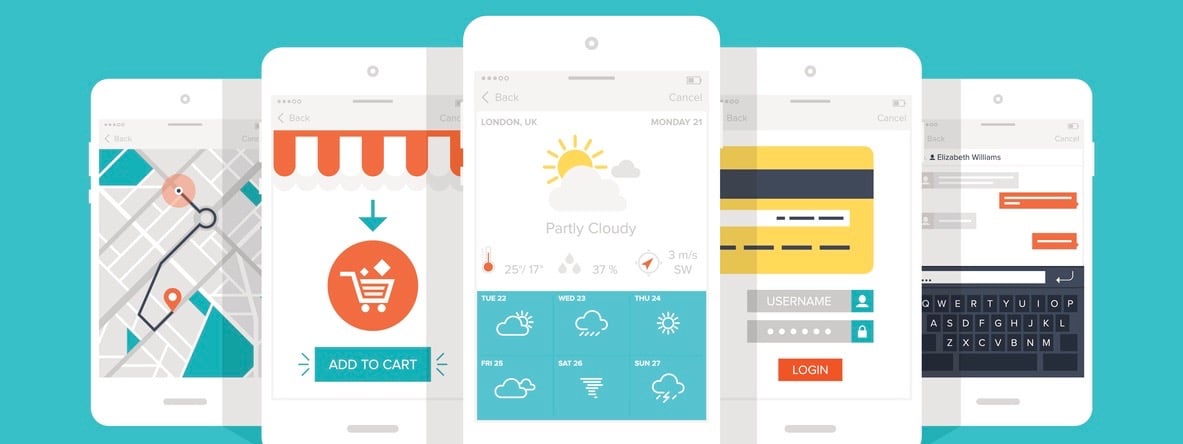Can you imagine your life without mobile apps? At first glance, they may not seem that integral to our lifestyle, but when you think about it, we use them every day. You listen to music, you use GPS, you watch Netflix, you try to measure something on your phone—all the little things we do every single day, they all require apps.
In fact, our worlds revolve around apps more than you probably realize. Let’s look at some of the ways we use apps.
You use apps more than you think
- Did you know that in 2020 alone, there were 218 billion app downloads? If every single person on earth downloaded apps, that would mean that we all have around 28, but since there’s a significant number of people who don’t use apps, smartphones, or technology, at all, that means the number is even higher for developed nations.
In fact, it comes out to about 250 million app downloads every single day, and the number is rising steadily as tech reaches more and more people and we become even more reliant on apps.
- 90 percent of our time using our phones (which amounts to almost 4 hours per day!) is dedicated to app use, which seems surprising, until you realize that virtually every feature on our phones is accessed via an app. From internet browsers to music to movies and even simple things like chatting with friends, they all use apps.
What does this mean for you? Apps are not just the future of marketing, but the future of any communications effort, if one wants to remain relevant. We have to continue to make efforts to adapt and capture the attention of the audience via the medium they use the most. Right now, and for the foreseeable future, that is overwhelmingly smartphone apps.
Apple vs. Android
- Although there’s plenty of variety when it comes to phone manufacturers and operating systems, smartphone users are largely divided into two camps: you’re either an Apple user or an Android user. Nowhere is that more obvious than when it comes to shopping for apps in their respective stores.
- Both app stores have plenty of diversity when it comes to the type of app they host, with Apple sitting at around 2.1 million apps, with the Google Play store surpassing it by 1 million apps. More are added every day.
- Google Play gets more overall downloads, which can mean a few different things. On one hand, it’s a sign of growth – users enjoy apps, they download them, and they use them. On the other hand, it can also be a sign that people are less satisfied with the apps they download, thus pushing them to try more alternatives. Either way, the obvious conclusion is that Android users get to experience more diversity and experimentation, which encourages them do download and use more apps.
- Unsurprisingly, users avoid paying for an app at the time of purchase, so free apps are favored. However, free apps on both the Apple Store and the Google Store typically create revenue through ads, micro-transactions, or paid accounts, as a way to monetize their product.
What does this mean for you? In using apps as a marketing tool long-term, diversity is key. A free app is an absolute must to attract users, and creating different options or otherwise improving an updating an existing app is a great strategy. Micro-transactions and ads are still the primary way to monetize an app, but it does interfere with the user experience, so you might consider leaving that out in order to create an ideal experience.
Social media apps
- With 3.5 billion social media users, it’s no wonder that social media and messaging apps are among the most popular app options for users all over the world. They spend an average of 3 hours per day on social media apps, with the vast majority accessing them on their smartphones vs. computers or other alternatives.
- It won’t come as a shock that the most popular social media app is Facebook, with YouTube coming in right behind it, followed by WhatsApp. In fourth place is Facebook Messenger, and then Instagram. It’s interesting to note that 4 out of 5 apps in the top spots are owned by Facebook, so they’ve clearly got a hold on this sector.
- It’s important to note that this ranking is subject to change, and it depends on trends. New social media apps are popping up every day, with newer apps gaining huge popularity and possibly overtaking some of the older leaders in future years. TikTok is a worthy opponent that is massively popular with Gen Z users, in particular.
What does this mean for you? When it comes to social media, you want to be ahead of the curve, so the smart move is to always hop on the latest platform that is favored by teenagers. Marketing here is your golden ticket, as is optimizing for mobile devices. Since 90 percent of your audience is present on social media, it’s a matter of choosing the right platform for your target audience.
Entertainment through apps
- A lot of our time spent on smart devices is accounted for with entertainment apps, whether they’re streaming services or mobile games. Because our mobile devices are so capable now, it’s like having a portable computer with us at all times, thus the change in the way we use our phones every day.
- Among streaming apps, Netflix is the undefeated champion, but Amazon Prime, Hulu, or Disney+ are also options that are gaining popularity, especially as more and more content is leaving Netflix and is once more divided between several different providers.
- When it comes to games, a definite ranking is more difficult to create, if not impossible. There are so many different games coming out every day and their popularity is ever-changing. What’s hot this month may not be so next month.
- If we take into consideration free video apps, YouTube reigns supreme and has for years. It’s difficult to compete because of the sheer amount of free content it provides, with users spending around 40 minutes on the platform every day.
What does this mean for you? It’s obvious that video is one major player and a big draw for users, so investing in video content is a smart move. If you can provide free content, that’s great, so a YouTube channel might be mandatory. YouTube videos are free, popular, and very easy to disseminate, which is extremely important when you’re trying to craft a viral internet moment.
Looking towards the future
When looking towards the future, there are two things that stand out: voice assistants and virtual reality. With their popularity growing, it is estimated that 93 percent of consumers will own and use a voice assistant as soon as 2023. In addition, there is an opportunity here with the introduction of ads via voice technology.
As for virtual reality, it cannot be contested that it represents the future of gaming, with mobile applications of the technology not being too far behind.








